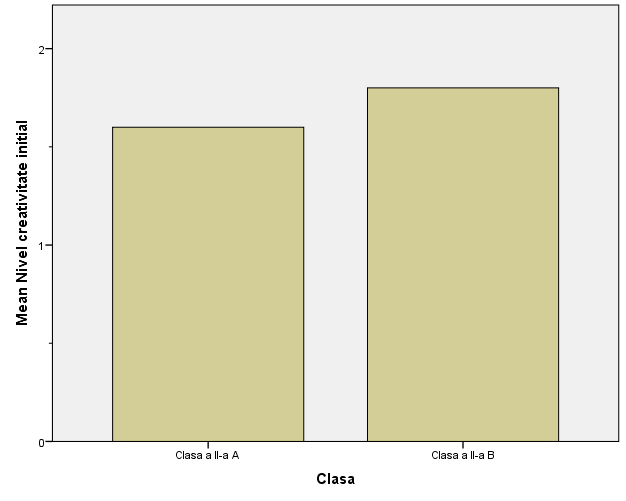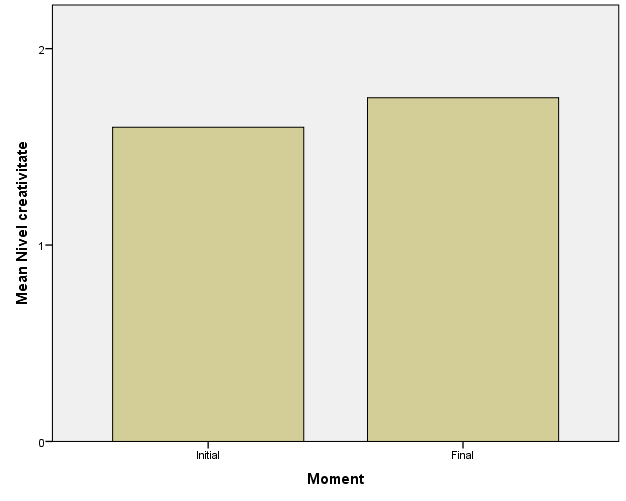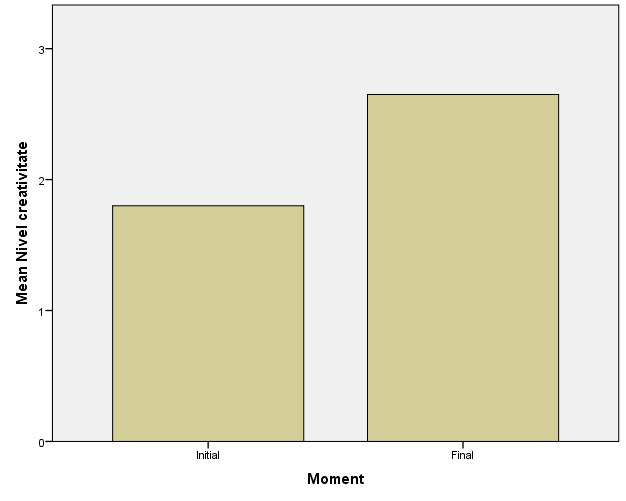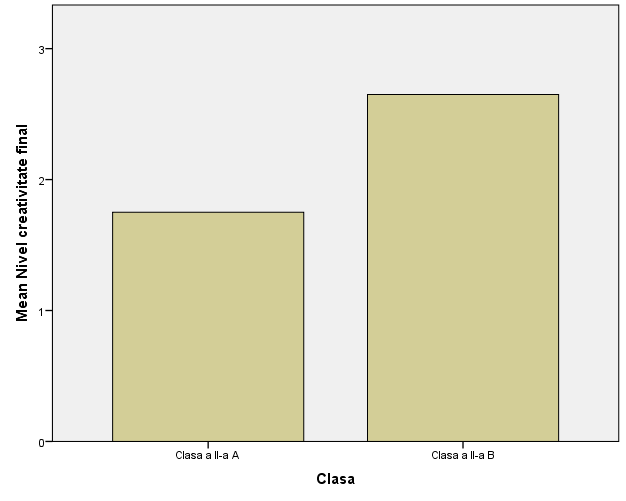Abstract
Problem Statement: Creativity is a common theme for science of education, but represents a challenge for educational field from theoretical approach to practical one. Purpose of Study: The purpose of the study is to investigate the modalities to developm the specific level of creativity from primary school in Suceava County. Research Methods:The investigative part is done through the survey about some aspects of the creativity process in primary school and we investigate the diferences between the students before and after educational intervention. The sample comprises 40 students from Bukovina County (ROMANIA). Findings: The students consider the creative process is depending on some factors (educational level, program of study and performance). In terms of the gained results we have described the diferences between our sample before educational intervantion and after creativity programme. Conclusions: The results obtained after the quantitative and qualitative analysis help to figure out more clearly the roles and the ideal methods for stimulating creativity process in primary education. The final data helps to build a better system for teaching in primary school and for the optimizing the quality of the teaching process for development of creativity.
Keywords: Creativity; process; primary school; teacher’s methodsperceptions of students
Introduction
This research was conducted based on the National Education Law (art. 2, alin. 1), which is
focused on „promoting an education oriented on values, creativity, cognitive, volitional and action
abilities, fundamental knowledge, competences and abilities of direct utility, in a profession or society”.
In the context of a continuously transforming reality, which stresses the individual in its personality
complexity, creativity is a basic quality which allows the exploration of a problem – matter by a divergent
thinking, envisioning multiple approaching perspectives in order to identify the right solution.
From this perspective it is necessary that the pupils are well prepared, achieve competences and
abilities to help them be creative, active, competitive, therefore performing within educational activities
and then, in the society (Cameron & Lively, 2013). These competences – though innate- can be developed
throughout life, fact that determined me to make a point by this study, about the impact that, the
creativity stimulation methods, techniques and procedures presented here, have on the divergent thinking,
imagination and the pupils’ creative attitudes. It has to be stated however, that the formative-educative
effects of the presented strategies are directly related to the level of engagement and both individual and
collective participation in the learning and development process (Starco, 2010; Clipa&Iorga, 2013;
Clipa&Boghean (2015),). Encouraging the child’s creativity since school becomes necessary given the
fact that this individual ability can be identified by the teacher by specific tests, techniques and methods
and can be developed taking into account each child’s skill, on different fields (Torrance, 1984; Stern &
Dearborn, 1998).
Methodology of Research
This paper is based on an experimental – analytical research within two 2nd grade classes from
School No.1 in Vicovu de Sus, Suceava County from Romania.
years old tested previously and how the creative-imaginative functions can develop in three months as a
result of the specific strategies applied for creativity development. The final testing will reveal the impact
of these strategies used mainly only in the case of one of the two classes formed of same age students.
The objectiveswere set starting from the theoretical premises presented in the first part of the paper. 1. The main objective considers establishing the pupils’ creativity level from the 1st and 2nd grade,
from two heterogeneous classes formed of pupils of 8 and 9 years old, from the urban area (40 children).
2. We aimed also at finding out to what extent pupils’ creativity is developed as a result of the
consequent usage in school activity of the strategies that stimulate the imaginative functions, on a three
months period, as compared to the level of the pupils creativity from the class in which this psychic
quality development was not a priority for the teacher.
Research plan
The following
∗The usage of the creativity stimulation, independent variable, determines the eventual existence of some significant differences regarding the comparative level of the children creativity from the two plots: the experimental one ( in which there were applied strategies specific for creativity stimulation) ant the one of control (which did not target the preponderant implementation of these strategies) ;
∗The age of the pupils suggested as samples (small school age- 2nd grade), the independent variable directly measurable, required the adjustment of the tests and the suggested strategies at the level of the children understanding;
∗The innate creative disponibilities of the subjects is another independent variable, relevant for the study and measurable by specific methods, which are the basis for the efficiency of the targeted strategies;
∗As dependent variable is taken into account the pupils’ involvement degree in solving the tasks and the skills they have to solve the tasks creatively.
Research hypothesis
1. Into two heterogeneous classes, in which the teacher creates a stimulating environment, the
pupils’ creativity is displayed differently, but very close as a comparative level between the pupils into
the two classes.
2. If there are used stimulating methods for creativity on a three months period, it will be noticed
an increment of the pupils’ creativity as a result of the test.
3. For the pupils from the class where no stimulating methods were applied, the final test will
reveal a hold-up, or a very sensitive increment of the creative ability.
The evolution period of the research
The research was done for a six months period (November 2015 – May 2016) and it developed
in the following stages:
a) In the
documenting on the subject and the existing literature with a detailed approach of the official curricular
documents, as well as the theoretic framework.
The research design was projected: hypothesis design, setting the objectives, drafting a unitary and
coherent project and designing demonstrative materials necessary to the educational experiment including
in the research, practicing the new methodologies. There were selected the samples, the data regarding
the variables involved in the research were registered and it was done an initial assessment of the pupils
achievements from the two samples.
b) The
during a three months period and there were used the strategies specific to the critical thinking,
collaborative learning, a large range of techniques and active-participative methods’ development for
imagination and creativity stimulation, adjusted to the pupils involved in the experiment.
c) The next stage is the one of final testing of the pupils from the two 2nd grade classes.
d) The final stage of the research is the one of the resulted performances assessment and final
conclusions drawing, regarding the correctness of the hypothesis and the educational endeavours done by
the use of stimulation methods for the pupils’ creative potential.
The sampling
Considering the objectives, the following sampling method was chosen: two samples, one
experimental and a control one.
The research was done in the classes II A and B from the School no.1, Vicovu de Sus, Suceava,
Romania. The experimental sample had 20 subjects, pupils from II B, who worked using mainly
creativity stimulation strategies, while the control sample was formed of 20 subjects from II A in the
same school. In this group there were not used the same strategies the pupils being taught normal
lessons, reach in content and correct from a methodical point of view, according to the curricula, but with
no special attention to the pupils creativity development. The samples were independent.
The instruments use
In order to reach the aim and to prove the hypothesis both the psycho-pedagogic method and the
experiment were used. Namely, we applied to the two 2nd grade classrooms subjects a 135 minutes test
(45min.*3), in different days, comprising nine items relevant for the identification of the pupils’ creative
skills, by comparing the results of the test from both classes. For the experimental sample there were
applied in the following three months, during the instructive-educative process, strategies for creativity
stimulation. After this period the same test was applied again in order to prove the extent to which the
pupils’ creativity was stimulated in the classroom which used these strategies compared to the pupils
from the other classroom who worked normally.
In order to prove if there is a statistic difference before the application of the creativity stimulation
methods between the means of the creativity level of the II A pupils as compared to the mean of the II B
pupils we applied the t test for independent samples.
Results
The results indicated that there is no significant difference between the two creativity levels, II
A(M=1,60; SD=0,681; N=20) and II B (M=1,80; SD=0,696; N=20): [t(38)=-0,919; p=0,364; p>0,05].

These results prove the fact that the II A class level of creativity mean is close to the mean of the II
B pupils (Figure
creates a stimulating environment, the pupils creativity manifests in different degrees, but very close
when compared between the two classes” is confirmed.
In order to compare the creativity level of the pupils in the II A grade at the first test with the level
at the second one, we applied the t test for pair samples.
The results indicated that there is no significant difference from a statistic point of view between
the level of creativity from the first test (M=1,60; SD=0,681; N=20) and the second one (M=1,75;
SD=0,716; N=20): [t(19)=-1,831; p=0,083; p>0,05].

The normal lessons without any particular preoccupation towards creativity stimulation had no
significant effect on changing pupils creativity level (Figure
from class II A is almost unchanged from the first application of the test to the second one. The
hypothesis according to which “In the case of the pupils in whose classroom were not applied stimulating
methods the final testing will prove a stagnation or a slow increment of the creativity” is confirmed.
In order to compare creativity levels of the pupils from II B before and after the application of the
creativity stimulating method, t test was applied for pair samples.
The results proved that there is a significant statistic difference between the pupils creativity level
before (M=1,80; SD=0,696; N=20) and after (M=2,65; SD=0,587; N=20): [t(19)=-7,678; p=0,000;
p<0,05] applying the creativity stimulating methods.

The use of the methods targeting creativity development influences pupils’ creativity. In other
words, the creativity level of the pupils in II B is better after putting into practice these methods then prior
to them. The hypothesis “If creativity stimulation methods are used for three months it will be noticed an
improvement of pupils’ creativity as a result of the test applied”.The hypothesis was confirmed.
In order to verify if there is a statistical difference, after applying the creativity development
methods, between the means of the pupils’ creativity level in the two classrooms, a t test for independent
samples was applied.
The results indicated that there is a significant difference between both means of the creativity
level of the pupils in II A (M=1,75; SD=0,716; N=20) and II B (M=2,65; SD=0,587; N=20):[t(36,590)=-
4,346;p=0,00;p<0,05]. These results reveal the fact that the pupils in II A have a lower creativity level
then the pupils in II B (Figure

In other words, after the three months during which we applied the creativity stimulation methods
in II B, while II A worked normally without aiming at developing these psychic abilities, it was noticed
that as a result of the second test the children from II B became more creative than the ones in II A. The
same results we found in others article (Langa, C, 2014).
Conclusions
In the case of small scholars it is considered that a product is original, creative, if it is new and
valuable to him. A creative act can be considered any act which requires the child to think divergently
and leads him to novel conclusions, resulted from an individual effort.
The chances that the pupils’ become creative persons increase, by:
- the discovery from the first years of school of the special skills and orient them to additional activity;
- the use of creativity stimulating methods;
- the use of creative exercises and games;
- interdisciplinary and learning by cooperation (Langa, C, 2014),
- the encouragement of expressing own points of view and assuming responsibilities;
- stimulating constructive competition between pupils.
The present paper aims at being an argument to support the creative behaviours of the pupils, in order
to encourage their skills, which later may lead to performances.
References
- Cameron, J., Lively, E. (2013). Cum să cultivi creativitatea copiilor. Exerciții pentru stimularea inventivității și stimei de sine. Iași: Editura Polirom.
- Clipa, O & Iorga, A.M (2013). The Role of school-family partnership in moral development of children, Procedia Social and Behavioral Sciences, vol. 76, 2013, pp. 197- 203, ISSN 1877-0428, Elsevier – Science Direct, http://www.sciencedirect.com/science/journal/18770428/76,
- Clipa, O. &Boghean, A. (2015). Stress factors and Solutions for the Phenomenon of Burnout of Preschool Teachers, in Procedia-Social and Behavioral Sciences, vol. 180, pp. 907-915, http://www.sciencedirect.com/science/article/pii/S1877042815015876
- Clipa, O. (2014). Transdisciplinarity and Communicative Action in Multidimensional Education. In RevistaRomaneascapentruEducatieMultidimensionala, Romanian Journal for Multidimensional Education, Ed. Lumen, vol. 6, Issue 2, pp. 9-1,
- Langa, Claudiu (2014). Social Media Impact on Primary Education Cycle Children s secondary socialisation, The International Scientific Conference eLearning and Software for Education; Bucharest 3: 256-261. Bucharest: "Carol I" National Defence University,
- Starco, A. J. (2010). Creativity in the Classroom. Schools of Curious Delight. Fourth edition. New York: Routledge
- Stern, W., Dearborn G. V. (1998). Blots of Ink in Experimental Psychology. Psychol. Review IV, Nr. 4, S. 390/91. Juli 1897'. Zeitschrift für Psychologie und Physiologie der Sinnesorgane, 17. Preluat de pe: http://echo.mpiwg-berlin.mpg.de/ECHOdocuView?url=/permanent/vlp/lit30449/index.meta
- Torrance, E. P. (1984). Tests of Creative Thinking. Preluat de pe Gifted Education: http://www.ststesting.com/ngifted.html
Copyright information

This work is licensed under a Creative Commons Attribution-NonCommercial-NoDerivatives 4.0 International License.
About this article
Publication Date
25 May 2017
Article Doi
eBook ISBN
978-1-80296-022-8
Publisher
Future Academy
Volume
23
Print ISBN (optional)
-
Edition Number
1st Edition
Pages
1-2032
Subjects
Educational strategies, educational policy, organization of education, management of education, teacher, teacher training
Cite this article as:
Clipa, O., & Juravle, V. (2017). Development Of Creativity In Primary School – Challenge And Possibilities. In E. Soare, & C. Langa (Eds.), Education Facing Contemporary World Issues, vol 23. European Proceedings of Social and Behavioural Sciences (pp. 1724-1732). Future Academy. https://doi.org/10.15405/epsbs.2017.05.02.211

